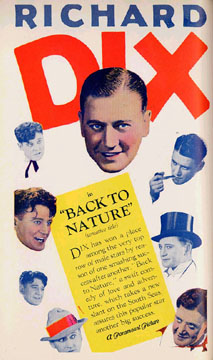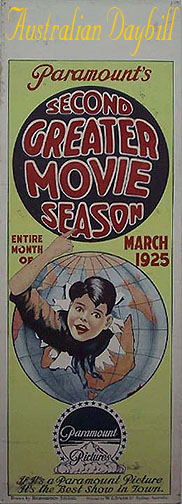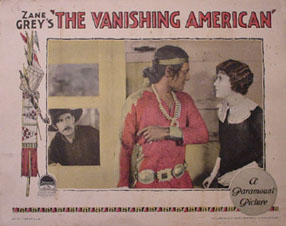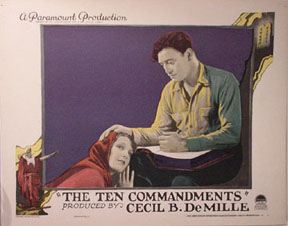 Trade Ad for the tentatively titled
Trade Ad for the tentatively titled"Back To Nature" aka "Sinners In Heaven" |

The Paramount Years
1923-1929
It was the death of star Wallace Reid that brought Richard Dix to Paramount in 1923. Eager to find someone to take the place of Reid's daredevil flare for action pictures, Dix was lured away from Goldwyn. He was different than Reid, more of the wholesome, All-American type. He easily conveyed the image of a strong, masculine male with a winning smile and a light-hearted attitude.From 1923 to 1929 Richard Dix made thirty-three pictures at Paramount. Several of them are still considered important films. Chief among his output was Cecil B. De Mille's The Ten Commandments in which he essayed the role of "good brother", John McTavish, in the modern part of the film.
Dix won wide acclaim from Native Americans for his sympathetic portrayal of Nophaie in Zane Grey's epic tale, The Vanishing American. He made two other Grey westerns, To The Last Man and Call Of The Canyon. His last silent, Redskin, was filmed, in part, using the two-strip techincolor process. It remains a classic to this day.
A rare, non-portrait, autographed photo!
In 1924 Richard Dix was sent to New York for nearly three years to work at Paramount's Astoria studios. He really liked New York, having worked there as an actor on the stage, and was delighted for the opportunity to head East. A straight-forward man, Dix never cared for the fake side of Hollywood publicity. He often spoke his mind with a disturbing frankness regarding press stories that passed off "bunk" as the truth about his life.
This was a particularly happy time for him. Dix first starring role came in 1924 when he played the part of Peter Minuit in Manhattan, a drama set in Hell's Kitchen. When Dix returned to California in 1927 troubling times lay ahead between the star and his studio.
1927 Japanese Fan Magazine Richard Dix, International Star!
Paramount did something which is still being done today. Exploiting the early work done by actors who have since become famous. In 1923, before Dix signed with Paramount, he made a picture for American Productions called Quicksands written by Howard Hawks. Dix had a featured role as a cavalry officer in this film about drug smuggling on the Mexican border. In 1927 Paramount bought the rights to Quicksands and, hoping to make a quick buck, re-released it promoting Dix as the star! Dix was furious and demanded to buy up his contract for 1 million dollars. Cash! The studio withdrew the picture and instead of taking Dix up on his offer gave him a salary hike. He now had a contract for 52 weeks a year making 4500 dollars a week.
Anxious to make his debut in sound pictures Richard Dix grew more impatient with Paramount. They kept him making profitable silents which could be sold to the many theaters that hadn't been adapted to sound.
When his friend, producer William Le Baron,left Paramount for RKO the end of his tenure there was inevitable. Seizing one last opportunity to exploit Dix, Paramount forced him to finish out his contract with three lackluster talkies. Paramount's loss was RKO's gain...



